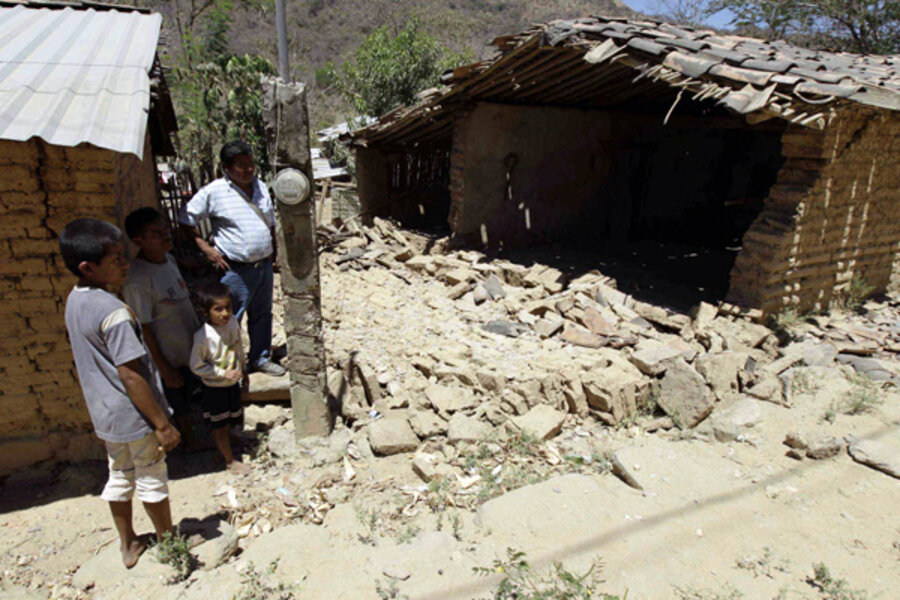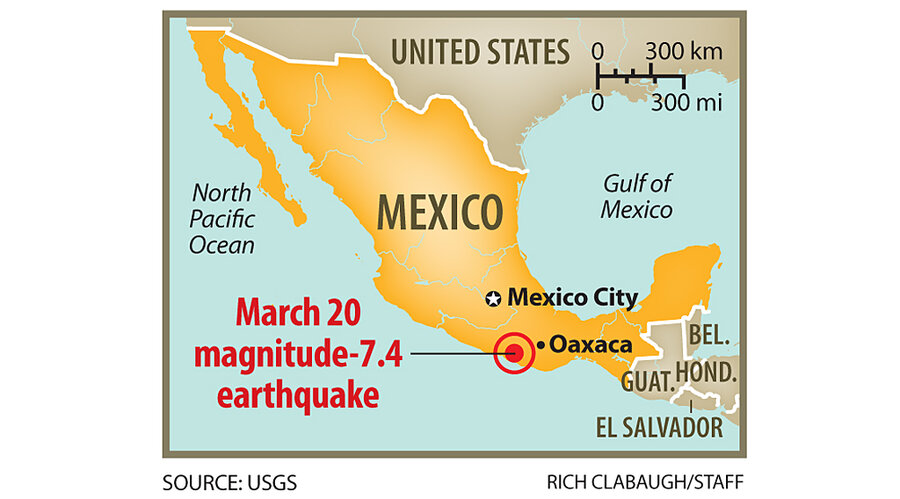Better prepared: Mexico's 7.4 quake causes damage, but no deaths
| Mexico City
By the time the powerful 7.4 earthquake rumbled in Mexico City Tuesday, the 56 students ages 6 months to 6 years attending the Montessori Kid's Place in Mexico City were already evacuated, gathered in the front lobby of the school, a location city engineers had earlier indicated as the safest spot.
“For a few seconds, nothing happened, and we thought it might be a false alarm,” says Claudia Yañez, the school director. She had purchased two alarms last year, each the size of a book, which warns them of seismic activity in Guerrero state. If an earthquake over the magnitude of 5 strikes, an alarm sounds and a voice warns “earthquake,” as it did Tuesday, giving them a minute of time to implement the drills they practice monthly. The minute represents the time between the triggering of the radio alert at the remote sensor and the arrival of the seismic shocks to Mexico City. “This minute is very valuable,” Ms. Yañez says.
Tuesday's earthquake was one of the strongest that residents have felt in the capital since the 1985 quake that killed some 10,000, and still haunts many. Nearly 30 years later, yesterday's quake caused damage but killed no one, according to public authorities.
The country was spared, in part, by the lesser energy of the quake and the way it hit. Stricter building codes have also ensured that homes and office spaces can withstand seismic activity better than in the past. But the city's preparedness, in the form of evacuation drills in schools, hospitals, offices, gas stations, and even in private homes has also evolved as a powerful preventive tool.
“The Mexican populace knows what to do when confronted with an earthquake,” says Mexico City's Civil Protection Secretary Elias Moreno Brizuela.“That was clearly demonstrated yesterday.”
Mexico City has professionalized its disaster response since the 1985 quake, and planning gotten even more attention under Mexico City Mayor Marcelo Ebrard. He raised the profile of the city’s “civil protection” department by making it a cabinet-level ministry in 2007. The ministry then created a detailed, six-point disaster-response program that spells out how each arm of government – in conjunction with private companies, including construction outfits that participate in reviewing damaged structures and hotels in the event that displaced residents need shelter – should react during a disaster.
Within seconds of Tuesday’s earthquake, the city set into motion its six-point plan. Six Condor helicopters took to the skies, one heading to pick up the mayor while the other five flew to their respective zones to immediately begin surveying damage across the immense metropolis of 20 million. Mayor Ebrard and Mr. Moreno Brizuela met at the city’s control center, where information was gathered and filtered from the city’s boroughs, various offices, and federal and state governments.
The earthquake struck at 12:02 p.m.. Sixteen minutes later, Ebrard tweeted that he was exiting the helicopter and within another 10 minutes had already communicated about the state of strategic services, the metro, water, electricity, and schools.
“As a government, we have advanced enormously,” Moreno Brizuela says.
Mexico City, which was built on a lakebed that amplifies the waves that radiate out from an earthquake’s center, has suffered worse fates during lesser or equally powerful earthquakes decades ago. In 1957, a 7.7 quake brought down buildings and the city’s iconic Angel of Independence monument. Seven hundred people died. In 1979, buildings crumbled during a powerful 7.9 tremor that also caused numerous deaths. In the 1985 quake, 400 buildings were damaged.
The damage of yesterday's quake is estimated at $100 million, according to risk-modeling firm Eqecat. But there have been no fatalities. It helped that the epicenter was situated in a sparsely populated region in southern Guerrero state. There, about 800 homes were damaged, officials say, including 60 that collapsed.
In Mexico City, subway lines were bent and a pedestrian bridge collapsed onto a bus that was empty of passengers. In the neighborhood of Condesa, one of the most vulnerable to seismic activity, and where the Montessori Kid's Place is located, plaster fell off of walls and windows were broken.
But the fact that Tuesday’s quake caused no deaths at all is a testament to strengthened building codes and preparedness, says Don Blakeman, a geophysicist with the Colorado-based US Geological Survey. “Since the big quake that occurred in ‘85, a lot of buildings that weren’t built too well came down in that disaster,” he says. “The building codes were strengthened and the city was better prepared.”
There are still challenges. An editorial in the daily El Universal praised the country's preparedness, from alarms activating to civil protection agents mobilizing, but warned that Mexico should not let its guard down (link in Spanish). "In Japan, last year, and in Chile in 2010, for example, with earthquakes of 9 and 8.8 respectively, the consequences were catastrophic. And these are countries that are very well prepared, more than Mexico probably," it reads.
Moreno Brizuela indicated that while many government entities now have earthquake alarms, the city is still working to implement a more comprehensive and effective alert system. The alarm purchased by the Montessori was a private decision, not part of a government standard.
But there is definitely more professionalization in the protection sector, says Yañez. She pulls out a stuffed white binder with all of the school's inspection obligations, from building codes to gas to electricity, and the trainings completed by each staff member. Before, she says, paperwork was scant and inspectors may have given a building a pass with a bribe.
That has evolved with a greater social consciousness about disaster preparedness. “Before we didn't talk about civil protection. We weren't prepared,” says Rodolfo Ramos Mendez, a doctor of the Montessori Kid's Place. “There is a consciousness today that we have to have a plan.”
The school carries out monthly drills for all emergency situations, from fires to structural damage, each adult wearing a whistle and knowing exactly who shepherds which classroom. For example, the school secretary is in charge of the babies.
After the quake Tuesday, the lights went out and cellphone service was down. But within 20 minutes, all parents had received an email from the president of the parents's association that their children were fine, that school was continuing, but that they could come by to pick up their children if they desired.
It's not just in schools where standards have improved and drills taken more seriously, though. Abner García Benitez was at his desk on the 21st floor of a global bank on Reforma Avenue when the skyscraper began to pitch and sway. An alarm sounded, and a voice over a loudspeaker began to instruct employees in what to do.
He had been through this once before, in September – but that was an earthquake drill. This was the real thing. “It felt so strong, like the building was dancing,” he says. “We all gathered against the wall near the stairs, far away from the windows.”
In practice, “there was a little bit of disorder,” he says. “Some people let panic get hold of them and they rushed down early.”
But there was also a sense that the drills helped, and the evacuation went as planned. Then they were back to work, business as usual.







